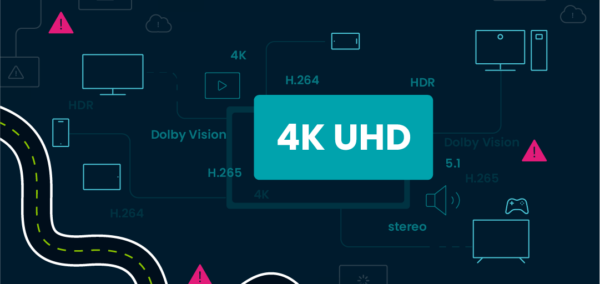
More 4K devices hit the market every day. Adoption seems to be on track with similar industry-wide changes in the past. Your competitors might have made the move already — or maybe you’re beating them to the punch.
Whether it’s for brand hygiene or quality of experience, your migration will face a number of business and technical challenges. In the next few minutes, you’ll learn how you can overcome this complexity and deliver on your Ultra High Definition promises.
Key Takeaways:
-
- You need to deliver UHD content despite diverse device capabilities.
- Business challenges can include everything from quality control to contract compliance.
- Public adoption of 4K is on track; the trend is led by cheaper devices.
- Every-user, every-second, multi-dimensional analytics help identify migration pain points and meet various goals including those for cost of ownership, QoE and device support.
Understanding Technical Complexity During 4K Migration
Complexity is a given with any type of data migration. Whether the migration involves a new productivity suite or a core business process, the combination of tech and human factors can get messy.
With 4K, the complexity comes from a few different sources. The usual suspects include:
-
- Video and audio encoding
- End-user device capabilities
- Licensing agreements
Your major technical hurdle is likely to be audiovisual encoding and compression, specifically the level of dimensionality beyond what your organization is probably used to. You’ll probably have to deliver:
- 264 and H.265 4K streams in parallel
- Multiple sound options, such as stereo and 5.1
- Multiple color ranges, such as Dolby Vision and HDR
Why bother? The main reason you have to satisfy all of these different formats is the fragmentation of audience device capabilities. Some users simply won’t have compatibility with certain codecs, color ranges, or audio profiles. Low-level analytics combined with fine-tuned multi-CDN configuration can help you laser-target regional user capacities and lower the cost of ownership of 4K.
There’s more: You probably have licensing agreements that bury UHD rights deep in the fine print. Failing to review your contracts before serving content could quickly turn your competitive advantage into a legal risk.
Gauging 4K Delivery Performance
Your current quality control processes should apply well to 4K. The key is to use analytics and isolate patterns. This avoids overgeneralizing in a complex environment, which, in turn, helps you allocate resources efficiently.
In the case of systemic failures, packet loss can of course seriously diminish QoE in a UHD stream just as it can in Standard Definition or High Definition. That means maintaining an overview of network performance and fine-tuning content delivery networks is still important.
There’s more to it, though. Ultra HD 4K is transitioning from a luxury perk to a core service. You need individual data on viewer-experience impact — and exactly what your audience is doing in response to stream degradation — to help guide your decisions about service.
Evaluating 4K Adoption Trends
At this point, 4K might seem like more trouble than it’s worth. Should you even pursue migration? The trends indicate that UHD is coming, complexity or not.
One major indicator is that UHD devices started gaining steam a few years ago. Consumers started seeing much lower prices, especially in terms of screens.
Lower prices are important. People have typically kept their cash rather than pay a high premium for enhanced broadcast images. That’s one of the reasons it took almost 30 years for color TV sets to fully replace black-and-white in homes.
Cheap UHD screens and budget 4K streaming equipment options are obviously good signs in this context. At the very least, this trend indicates that many users have the capability to receive higher-quality streams.
There’s a lot that needs to happen for general 4K streaming adoption other than just end-user device availability:
-
- Target regions need adequate infrastructure and technology to transmit UHD signals.
- Customers need to choose to buy services that enable high-bandwidth transmission.
- Service providers, such as ISPs, need to empower broadcasters with tools to maintain QoE.
The question then becomes when all of these factors will come together and solidify 4K’s place in the market. The answer seems to be “soon.”
Looking Beyond Bitrate Benchmarks: Navigating Multi-Dimensional Complexities
People like sharper pictures more. It seems simple on the face of it.
Higher definitions have better opinion baselines. The opinion scores increase with higher bitrates. It seems like all you have to do is increase your bitrate and serve everything in UHD, but that’s not the case. At least, it’s more complex than that when it comes to tracking the performance of a 4K migration.
For example, are your analytics set up to show H.264 and H.265 sessions separately? These two codecs can (essentially) deliver the same UHD video quality at significantly different network loads: 32 Mbps for 4K with H.264 vs. about 19 Mbps with H.265. You’ll need to track streaming metrics other than bitrate when delivery cost and a fragmented device landscape are in the equation.
Recognizing the Type of Demand for 4K
On a strategic level, customer demand drives the change to 4K. How do you satisfy that demand on a tactical level?
Even some of the highest-demand streaming applications, such as live sports, have adopted 4K. In the on-demand arena, the prevailing industry attitude is that 4K is a brand-hygiene feature. Big video-on-demand players have rolled out 4K in various cost-effective ways, such as packaging UHD with premium, multi-stream subscription packages.
Is that going to work for your viewers? To answer that, your best resource will be your own data.
You need an analytics tool that can let you know exactly how much your audience values the 4K experience. Opinion polls are probably not going to cut it — it’s about what consumers do.
Do viewers keep watching when stream quality goes down? Do you see subscriber churn in areas with consistent delivery issues? Do people watch regardless, without noticing or caring when their experience degrades?
Moving Toward Strategic 4K Delivery
When you’re breaking new ground, you need to choose your actions carefully. Let Conviva help. Request a demo today to see how you can use every second of every viewer experience to make the best possible decisions.







